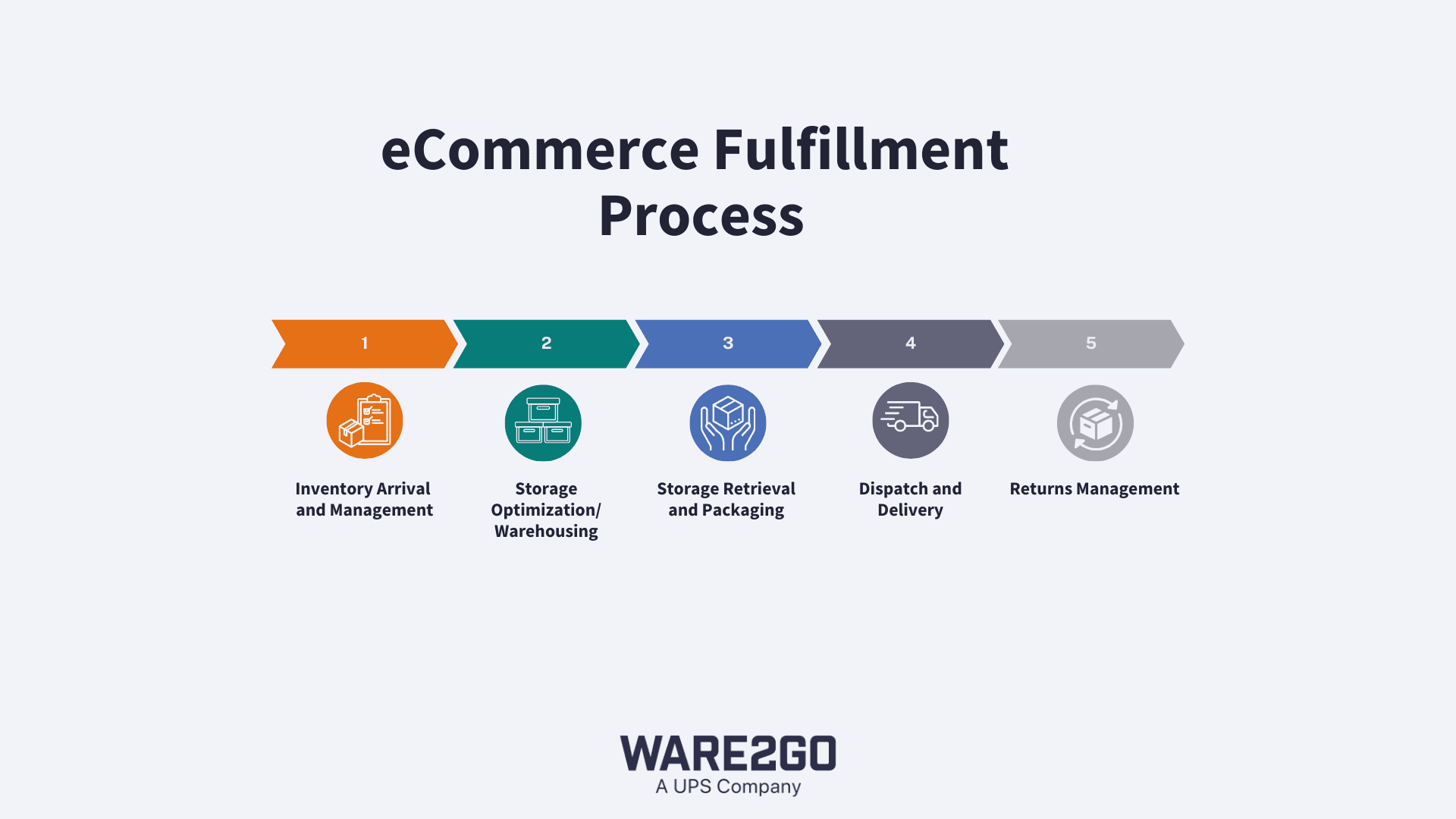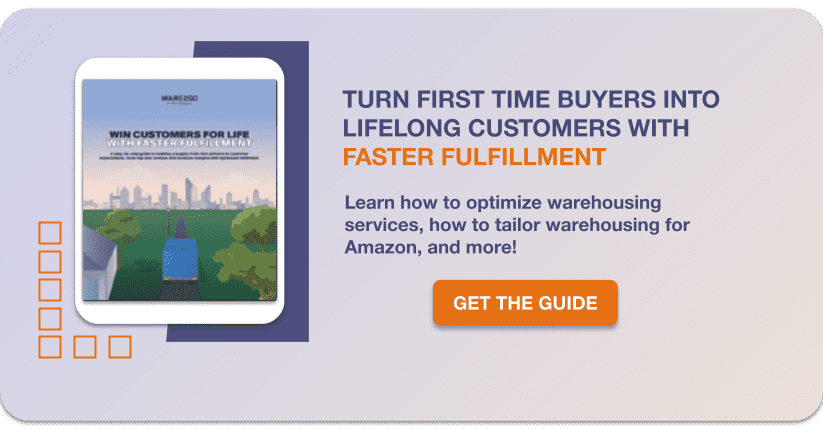Imagine your online store boasts the best products and your sales and marketing team is unrivaled. But have you fully thought through your eCommerce fulfillment services?
What do you do if once the order goes through, your customers wait… and wait? Chances are, they won’t return.
The stats don’t lie — the US cart abandonment rate hovers around 70%, with slow delivery among the top 5 culprits. That’s why having an efficient eCommerce fulfillment service is a must.
Read our step-by-step guide on how to exceed customer expectations consistently.
Consumers demand speed, and you must grasp the intricacies of fulfillment to deliver. We can help. With real-life case studies, we’ll show you how to create a rock-solid fulfillment service that keeps customers returning.
Let’s get started.
What Is eCommerce Fulfillment, and Why Does It Matter?
eCommerce order fulfillment is the final phase of your eCommerce supply chain. It involves storing products in an eCommerce fulfillment center, picking and packing orders, and shipping products to your end customer. These final steps in your supply chain are sometimes the most costly, so it’s important to have a well-thought-out eCommerce fulfillment strategy, including how to outsource fulfillment.
Global eCommerce growth shows no signs of slowing down. In 2024, it’s expected to increase by 9.4% to reach $6.3 billion. Customer expectations for fast shipping have consistently remained high.
Understanding how these expectations shape consumer preferences and drive customer lifetime value will help you see your fulfillment operations as an opportunity to differentiate yourself from your competitors.
A major benefit of eCommerce is the ability to scale quickly. If you can get your product in front of the right customers, sales have the potential to skyrocket overnight. However, if you can’t get your products into the hands of your customers quickly, you risk making a poor first impression on new customers.
Sports recovery drink, O2 Hydration, discovered that their ecommerce customers had a different set of expectations for fulfillment and delivery than their traditional brick and mortar partners. When they began to see exponential growth in their ecommerce sales volume, they knew they needed a fulfillment partner that could scale with them to meet their new customers’ expectations.
What Does the eCommerce Fulfillment Process Entail?
Let’s understand the different parts of the entire fulfillment process step-by-step.
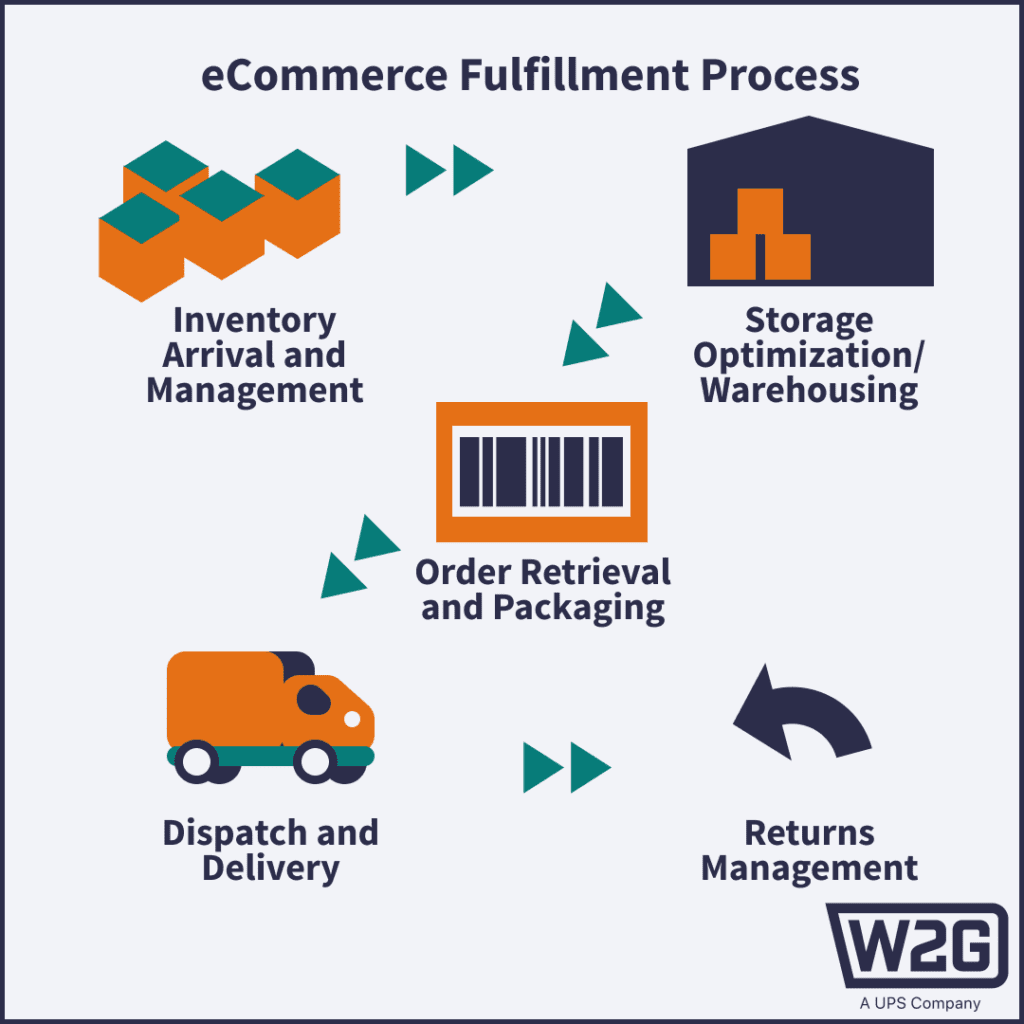
Inbounding Inventory
The process starts with the arrival of your inventory, either from your warehouse or a third-party supplier. Each shipment needs to be:
- Reconciled: Physical inventory is first reconciled against an Advanced Shipment Notice (ASN) to ensure that quantities of each SKU match the merchant’s electronic records. This protects against loss of product and inconsistencies that can lead to unexpected backorders and stockouts.
- Checked for quality: As products are checked in, they are all inspected for potential damage incurred in transit. Damaged products should be flagged to the merchant to update records and determine whether replacing, repairing, discounting, or liquidating the products is the best path forward.
- Putaway: Products are then organized and stored in designated warehouse locations (bins, shelves, or pallets) for easy picking later. SKU locations and counts are updated in the Warehouse Management System (WMS).
Following a standardized inbound process ensures accurate tracking, organization, and efficiency while minimizing inventory management. This enables more efficient ecommerce fulfillment for more satisfied customers and optimized fulfillment costs.
Warehousing
Once the goods are received, they’re immediately sent for delivery or stored in a fulfillment warehouse. In an eCommerce fulfillment center, products are in constant motion — either swiftly shipped out or strategically stored until they’re needed, based on real-time inventory changes.
Here’s why:
- Storage flexibility: Ecommerce fulfillment centers offer the ability to temporarily hold inventory based on demand or strategically distribute stock across multiple warehouse locations. This ensures faster delivery times for regional customers while adapting to fluctuating demand.
- Real-time inventory changes: Advanced systems update inventory levels in real time, ensuring accurate stock availability across all sales channels. This prevents overselling and helps businesses maintain customer satisfaction and operational efficiency.
Storage Optimization
Optimizing storage maximizes efficiency to ensure faster picking with fewer mis-picks. It also enables the most efficient use of space within the warehouse to minimize storage fees. Depending on the type of product, sales velocity, and warehouse capabilities, there are several different storage optimization techniques that ecommerce fulfillment centers employ, such as:
- Bin and shelf labeling: This technique assigns a designated location for every SKU, ensuring quick and accurate retrieval during the picking process. Clear labeling that is accurately tracked in a WMS improves warehouse organization and streamlines fulfillment operations.
- ABC Analysis: This storage system prioritizes fast-moving SKUs (A-movers) closest to the packing station for faster picking, while slower-moving SKUs (C-movers) are stored farther away to optimize pack patterns.
- First-In, First-Out (FIFO): This fulfillment method ensures older stock (first in) is picked and shipped first (first out), to reduce the risk of expired or obsolete inventory.
Inventory management
Effective inventory management is key to optimizing margins without sacrificing on customer experience. It is important to strike a balance between minimizing missed sales opportunities and keeping inventory carry costs at a minimum.
This is typically achieved by using tools and strategies, such as:
- A warehouse management system (WMS): A WMS syncs with your eCommerce shopping cart to update stock levels in real time, ensuring accurate inventory visibility across all sales channels.
- Inventory cycle counts: Rather than relying on annual audits, warehouses make frequent spot checks to verify that physical inventory counts match digital records. This ongoing approach minimizes disruptions by catching discrepancies early.
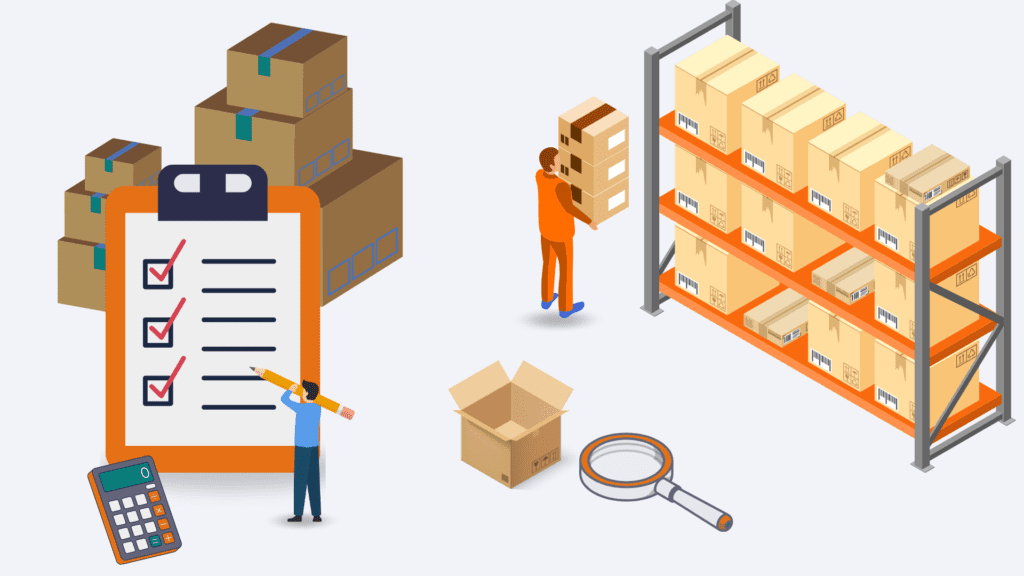
Together, these systems ensure accurate records across all sales channels and fulfillment centers to enable faster and more accurate fulfillment times and meet today’s consumer expectations for fast and reliable ecommerce delivery.
Order Retrieval and Packaging
This phase of ecommerce fulfillment, also known as picking and packing, is critical for ensuring that orders are shipped both quickly and accurately. At the heart of this process is the Warehouse Management System (WMS), which streamlines workflows, minimizes errors, and optimizes resources to maintain efficiency.
Once the order is routed from the sales channel, the WMS creates a pack path for warehouse staff to gather the correct items. There are a few approaches to picking that are suited for different situations:
- Single Order Picking: Ideal for smaller operations or high-value orders, this method ensures individual orders are picked one at a time, prioritizing accuracy.
- Batch Picking: This method consolidates multiple orders with similar items, allowing pickers to retrieve products in bulk, saving time and steps when efficiency is the highest priority.
- Zone Picking: Pickers work in specific areas of the warehouse, preparing portions of an order that are later combined in a sequential handoff process.
Once items are picked, the packaging process begins, designed to balance cost-effectiveness and customer satisfaction:
- Selecting Packaging Materials: The right-sized materials reduce dimensional weight, lowering shipping fees without compromising the integrity of the product.
- Adding Protective Padding: Bubble wrap, air pillows, or packing paper minimize the risk of damage during transit, safeguarding customer satisfaction.
- Including Packing Slips: These serve as a roadmap for the unboxing experience, listing order details while simplifying returns, if necessary.
The picking and packing process is the first physical step of the ecommerce fulfillment process and is crucial for fast and accurate delivery.
Shipping and Delivery
Once your order is packed, it leaves the fulfillment center to be delivered to your end customer—a critical stage in customer experience. Your choice of carrier and delivery options directly impacts your brand’s reputation.
- Carrier Selection: Most 3PL providers offer multiple carrier options, and rate shopping capabilities so you can choose the shipping methods that align with your business priorities, whether it’s cost-effectiveness, speed, or specialized services.
- Shipping Speed: Offering delivery options like same-day, 1-2 business days, or standard shipping comes with the responsibility of meeting those timelines consistently to uphold your promises to customers.
- Tracking Integration: Real-time tracking allows customers to follow their order’s journey from the warehouse to their doorstep, enhancing transparency and trust.
Whether you’re selling direct to consumer, wholesale to a major retailer, or limited quantities to a boutique or small retailer, delivery is a key driver of customer experience. Choose an ecommerce fulfillment partner with the carrier relationships and technology to optimize the delivery process.
Returns Management
Returns are an unavoidable aspect of the ecommerce fulfillment process. In fact, the return rate for online purchases has doubled since 2019, so an ecommerce fulfillment strategy must have a system in place to handle product returns that includes quality control, sorting, and accounting for inventory.
Here’s how fulfillment partners manage returns:
- Quality Control: Upon receipt, returned products undergo a thorough inspection to determine whether they are eligible for resale. Only undamaged, sellable products re-enter your inventory.
- Restocking: Items deemed fit for resale are promptly returned to stock and logged into the system, making them available for future orders.
- Refunds or Vendor Credits: Faulty or damaged items are either sent back to the manufacturer for vendor credit or processed for customer refunds.
- Recycling or Disposal: Products that cannot be resold or repaired are responsibly recycled or disposed of, prioritizing environmental sustainability and compliance.
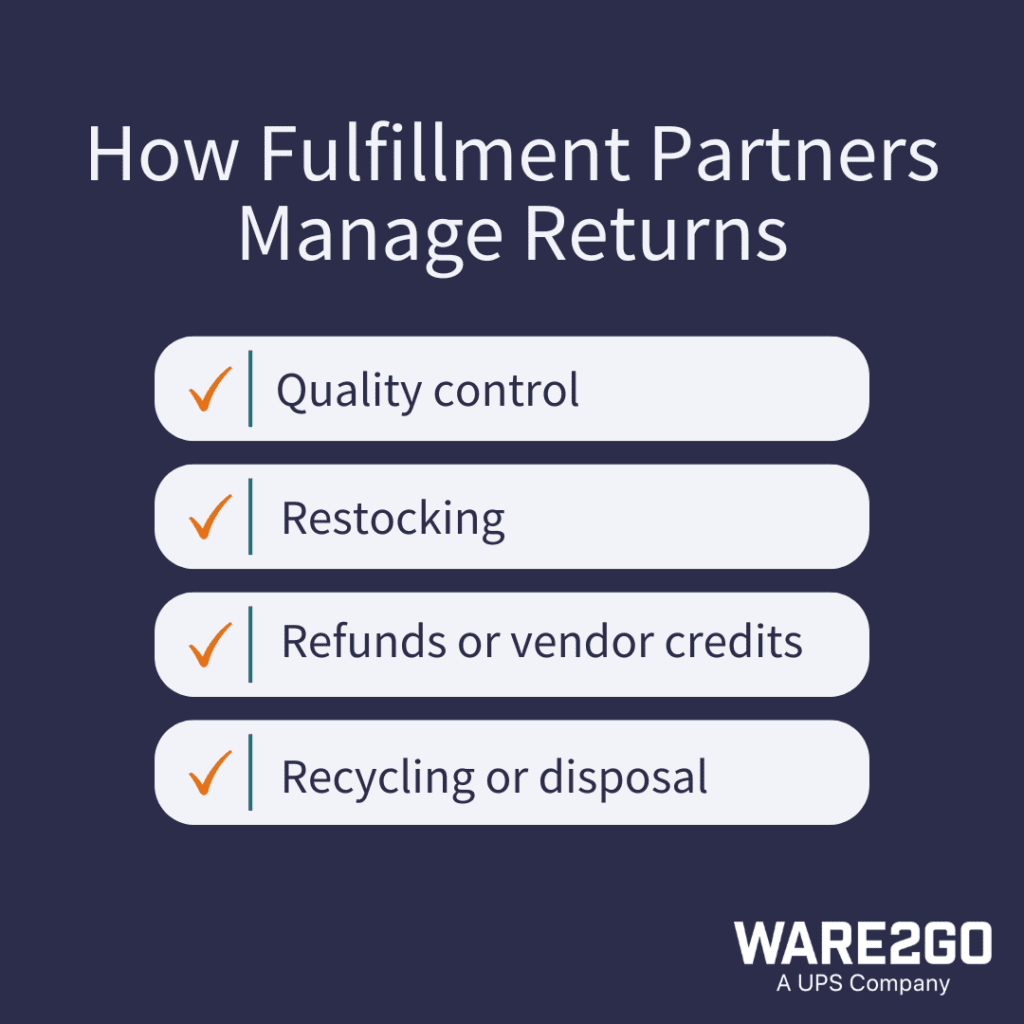
Why you need to customize your e-commerce fulfillment
No two businesses are alike—products, customer expectations, and delivery requirements vary. A “one-size-fits-all” approach won’t help you maximize resources or meet your customers’ expectations.
For instance, fragile products require specialized packaging and careful handling, while oversized items like furniture have specialized storage and retrieval requirements. High-value goods may call for expedited shipping options and additional tracking capabilities to ensure security and transparency.
Customizing your fulfillment operations empowers you to:
- Optimize Shipping Options: Offer the perfect balance of speed and cost, such as express delivery for time-sensitive orders or free shipping for higher-value purchases.
- Tailor Inventory Management: Align stock levels with seasonal trends or product life cycles and prioritize the sales channels that are most important to your business.
- Enhance the Customer Experience: Provide flexible delivery options, such as in-store pickup or scheduled deliveries, to meet your customers’ specific preferences.
Customized fulfillment creates a seamless and scalable operation that strengthens customer loyalty and supports long-term growth.
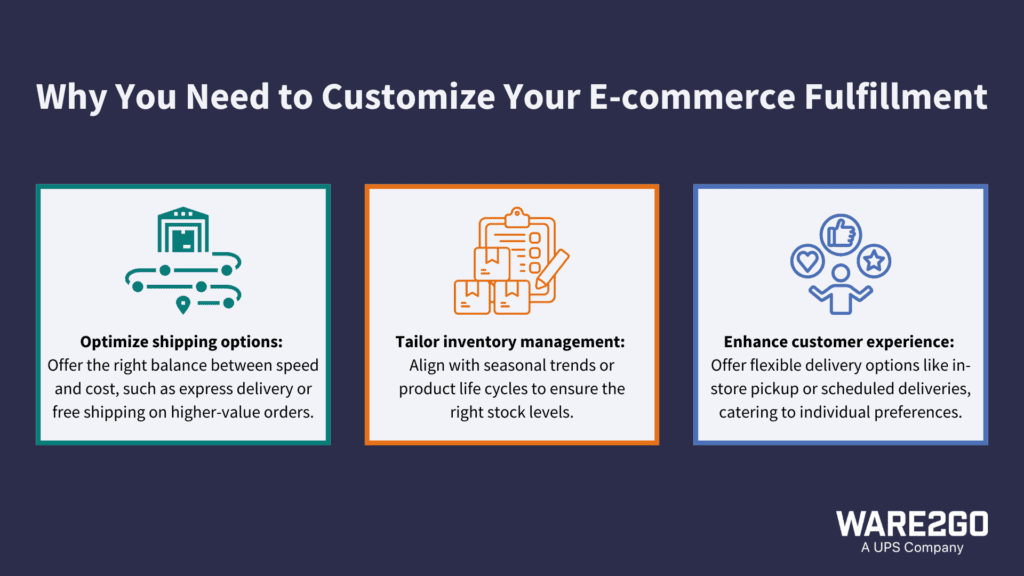
By adapting your fulfillment strategy, you reduce waste, improve delivery reliability, and create a seamless post-purchase experience that fosters customer loyalty and encourages repeat business.
Now, let’s explore the different eCommerce fulfillment models.
What Are the Different eCommerce Fulfillment Models?
Here are some eFulfillment services your business can choose from:
- Self-fulfillment – suits smaller merchants, giving full and direct control over inventory, packaging, and shipping, using platforms like Shopify for support.
- Third-party logistics (3PL) – helps growing businesses by outsourcing warehousing, packing, and delivery to experts for efficiency and cost reduction.
- Dropshipping – eliminates the need for merchants to hold inventory, with the supplier/manufacturer/distributor shipping directly to customers, making it ideal for minimizing upfront costs.
- Fourth Party Logistics (4PL) companies like Ware2Go – integrate a network of 3PL services for nationwide reach. This model offers scalable, on-demand warehousing close to customers for faster shipping.
Why Is It Important to Choose the Right Fulfillment Provider?
Selecting the right fulfillment provider is critical to meeting customer expectations, controlling costs, and scaling your business effectively. The right partner will serve as an extension of your team, prioritizing your business’s long-term growth.
A reliable partner ensures:
- Optimized Delivery Times: With multiple warehouse locations, inventory can be stored closer to customers, reducing shipping times and boosting satisfaction.
- Cost Efficiency: By minimizing packaging waste, consolidating shipments, and leveraging carrier partnerships, efficient providers help lower shipping costs.
- Scalable Operations: Flexible storage and fulfillment options enable you to adapt to seasonal demand spikes or rapid business growth without missing a beat.
- Seamless Integration: Advanced warehouse management systems integrate effortlessly with your eCommerce platform, providing accurate, real-time inventory tracking.
- Comprehensive Support: Value-added services like kitting, returns management, and quality control streamline operations while enhancing the customer experience.
In short, a well-aligned fulfillment partner is about more than delivering products—it’s about ensuring every post-purchase interaction builds trust, fosters loyalty, and encourages repeat business.
Now that you know why it’s important, let’s move on to how to choose the right solution for your business.

How to Choose the Right Ecommerce Fulfillment Provider For Your Business?
When you meet or exceed your customers’ expectations with faster delivery times and a seamless experience, they’re more likely to make a subsequent purchase.
So how do you decide which fulfillment solution is right for you?
The best place to start is by determining if your fulfillment strategy is encountering any obstacles, such as outgrowing your storage facilities or struggling to meet increasing customer demand for faster shipping.
Once you’ve identified these challenges, use the following checklist to determine your business’s specific needs and which type of eCommerce fulfillment provider is the right fit for your operations.
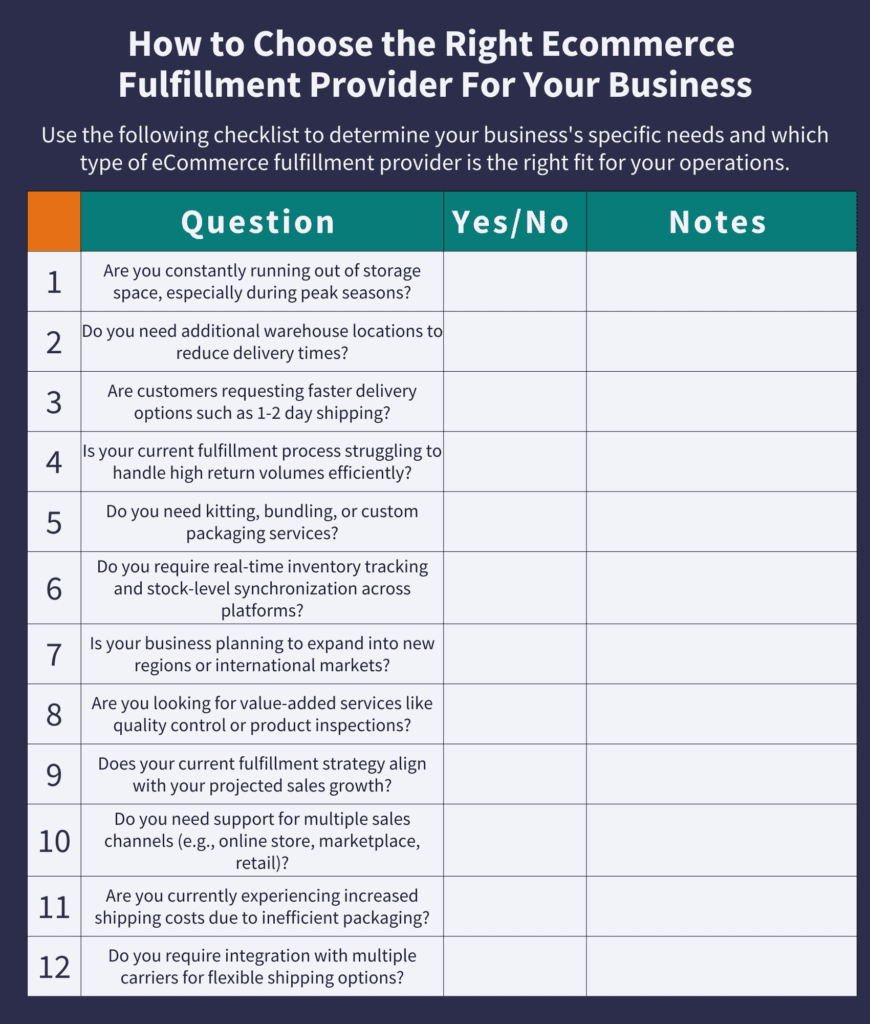
Answering these questions will help you identify the best fulfillment model — whether it’s self-fulfillment, third-party logistics (3PL), or fourth-party logistics (4PL) — to support your business growth and meet evolving customer expectations.
If you’ve checked “yes” on 4 or more of the questions above, Ware2Go can help. Ware2Go is a UPS company that provides end-to-end fulfillment and supply chain solutions with flexible agreements so brands can easily scale their operations up or down to meet the changing needs of their business. Click here to learn more.
What Are the Benefits of Third-Party Logistics?
Using a third-party logistics (3PL) partner for your eCommerce business does more than just save transit times and shipping costs. It’s like having a dedicated team of experts who adjust to your business’s ups and downs, giving you the correct warehouse space and support when needed.
This flexibility means you don’t have to sweat the small stuff, like packing boxes and storage space, and can spend more time on big-picture goals. Plus, these partners can get better deals on shipping because they’re aggregating shipping volume across all of their clients.
But here’s where it gets even better with a fourth-party logistics (4PL) provider like Ware2Go. Unlike traditional third-party logistics (3PL) providers that offer limited regional coverage and support, 4PLs operate on a larger scale.
4PLs like Ware2Go manage a network of 3PLs across the country, providing businesses with a nationwide warehouse network.
Advanced, cloud-based warehouse management systems integrate seamlessly with major eCommerce platforms and ERPs to support this setup. This means you get real-time inventory tracking and other insights into orders across all locations, making your fulfillment process smoother and more efficient.
Plus, by pooling resources from various merchants, 4PLs can secure better rates and service levels, making your expansion into new markets easier and more cost-effective.
Ware2Go, a UPS company, simplifies how products get to your customers by making fast, 1- to 2-day delivery accessible to all kinds of businesses. This means you can scale up without the headaches, offering your customers speedy deliveries.
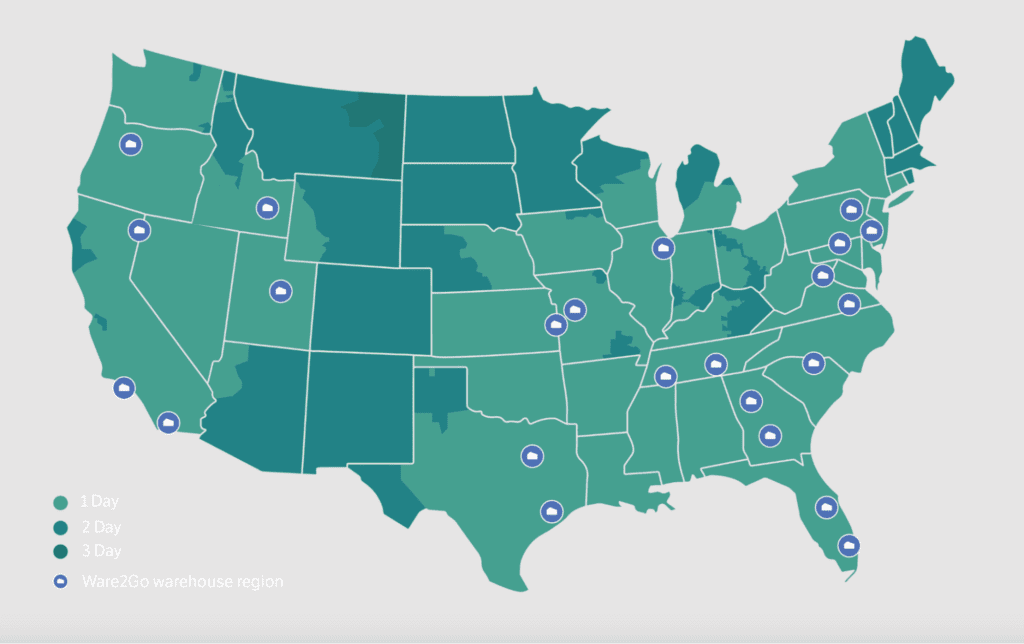
Case Study: Going to Market with a Fulfillment Strategy in Place
YBell Fitness (now called TRX training), a high-growth fitness brand, knew it had to prioritize eCommerce fulfillment before launching its online store. Their original go-to-market strategy in the U.S. was centered on large volume sales to gyms and fitness centers, but mandatory gym shutdowns sent them looking for a direct-to-consumer (D2C) sales channel to reach the growing number of consumers looking for home workout equipment.
Today, with the rise of user-friendly eCommerce platforms like BigCommerce and Shopify, setting up an online store is simpler than ever. However, Mark Livingston, VP of Worldwide Sales at YBell Fitness, knew its new storefront would only be viable with a reliable eCommerce fulfillment service before launch.
Mark’s experience in the fitness industry taught him that driving traffic to a site that was unable to meet customer shipping expectations and last-mile carrier tracking would only damage its brand.
While many merchants may have a laser focus on driving sales, a sales channel that isn’t supported by a fully optimized fulfillment strategy will ultimately lead to poor reviews, a decline in customer trust, and costly returns.
Ahead, we’ll examine how a holistic, end-to-end approach to your eCommerce strategy — beginning with eCommerce order fulfillment — will contribute to your company’s profitability and longevity.
Video Case Study: 100 Thieves + Ware2Go
The rise of social commerce (the process of selling products directly through social media platforms) has created viral opportunities for many fast-growing brands like 100 Thieves, a lifestyle brand for gaming enthusiasts and professionals.
They said that before they launched their new energy drink, Juvee, on Twitch, they had to have an eCommerce fulfillment solution in place to meet the demands of their large and enthusiastic online fanbase.
The brand’s launch strategy included partnering with Ware2Go that enabled them to handle high volumes of orders quickly. This setup allowed 100 Thieves to deliver their product within 1 to 2 days to 95% of their customers.
Ware2Go’s flexible services helped 100 Thieves to quickly adapt to consumer preferences through real-time inventory visibility and rapid repackaging and distribution.
This shows how a successful product launch combines strategic surprise, brand-centric product development, and efficient logistics management to create a strong market entry and maintain high customer engagement.
Why Should You Prioritize Fulfillment in Your eCommerce Strategy?
The goal of any eCommerce strategy is to make the customer experience as seamless as possible. The more friction points there are between discovery and purchase, the more likely a potential customer is to abandon a purchase.
Many emerging brands pay close attention to these friction points on the front end of their strategy. However, there are many more opportunities for friction during the back end and post-purchase segments of the customer journey.
Among other touchpoints, the backend and post-purchase are where an eCommerce fulfillment service can make an immediate impact.
How eCommerce Fulfillment Affects Front-End Strategy
Fulfillment and delivery promises can affect conversion rates as early as the product discovery phase. In fact, our 2021 survey revealed that 69% of consumers are more likely to click on an ad that mentions fast, free shipping.
With the changes to online privacy policies, impression share is going down while the price of those impressions is increasing. That means merchants must find every way they can to make the most of their marketing dollars. Prioritizing fulfillment early in your eCommerce strategy lets you geo-target shoppers with ads highlighting high-converting delivery promises.
Fulfillment Strategy at Checkout
Your cart conversion rate is an important metric for measuring the effectiveness of your website design and overall eCommerce strategy. A high cart abandonment rate indicates that something is happening in the final checkout phase to deter customers from actually making a purchase.
The culprit is usually one or more of the following:
- Shipping speed
- Shipping cost
- Unexpected charges
- Insufficient payment options
- Clumsy or time-consuming user experience
Two of these contributing factors are related to fulfillment. In fact, more than 68% of customers look for shorter shipping speed as the determining factor while placing online orders. Also, Statista found that 41% of buyers expected their products to arrive in 24 hours.
This shows how offering customers a speedy shipping option isn’t just a nice-to-have but a necessity.
The Post Checkout Experience and eCommerce Fulfillment
Offering 1- to 2-day shipping will draw customers in, but delivering on that promise will build invaluable brand equity. Satisfied first-time buyers become lifetime customers who leave positive online reviews, recommend your products to their friends, and spend more money on subsequent purchases.
The delivery experience is also your customer’s first in-person experience with your brand. A lackluster delivery experience can make a poor first impression and may even lead to an increase in returns.
Consumer Delivery Preferences for eCommerce Fulfillment in 2024
Today’s consumers have come to expect reliable 1- to 2-day shipping from growing businesses of all sizes. However, a report on eCommerce delivery preferences in 2023 revealed 90% of consumers are willing to forego same-day or 2-day shipping for other options, such as:
- Free shipping (70%)
- Real-time tracking (43%)
- Ability to choose a delivery date (31%)
- In-store pickup (27%)
- Consolidated shipments (24%)
See the full statistics on eCommerce customer delivery preferences here.
Video Case Study: EC4Kids and Ware2Go eCommerce Fulfillment Services
Children’s toy and furniture merchant ECR4Kids needed an eCommerce fulfillment solution that could grow with their business. They found that Ware2Go’s transparent pricing and easy-to-use technology platform simplified their existing fulfillment process and could easily be scaled up or down as needed.
FAQ section
What Is Fulfillment in eCommerce?
Fulfillment by an eCommerce company involves getting an online order from the website to the buyer’s doorstep. Once a customer clicks ‘buy,’ the process of picking, packing, and shipping the item begins so it can arrive safely at their home.
How Do You Fulfill an Order?
After someone orders from your online store, you (or a team you work with) find the product in your warehouse, pack it up securely, and ship it to the customer’s address. You can also use an eCommerce fulfillment services provider to do everything for you.
What Is an Example of Order Fulfillment?
Imagine a buyer who orders a backpack from an online store. The store then finds the backpack in their inventory, puts it in a box, adds a shipping label, and sends it off with a delivery service to reach you.
Your eCommerce Strategy and a Complete Fulfillment Service
An effective eCommerce fulfillment services strategy requires looking beyond the front-end sales and marketing functions and spending an equal amount of time and energy on optimizing the after-the-click experience. While effective sales and marketing efforts will drive customers to your site, a simple and efficient checkout and fulfillment process ultimately drives purchases and converts shoppers to loyal customers and brand ambassadors.
Ware2Go is an outsourced eCommerce fulfillment service that provides a fully flexible and scalable solution to enable eCommerce sellers of all sizes to meet customer expectations for delivery without sacrificing their bottom line.
Ware2Go’s technology-first approach to fulfillment allows emerging brands to connect all of their sales channels through a single platform, making inventory management, order management, and status reporting simple and low-touch.
Connect with us to learn how we can help you reach customers sooner with our guaranteed 2-day delivery.

